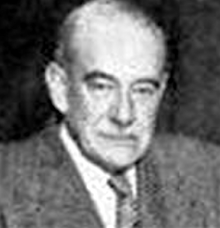
Harry Sutton Chorley [also known as Henry Sutton Charley] was born in Congleton, Cheshire, England on 14 April 1869. After studying History at Trinity College, Cambridge, from where he graduated in 1891, he was articled to his father, Charles Roberts Chorley (1829-1912) and John Wreghitt Connon (1849-1921) of Chorley & Connon in Leeds, Yorkshire. He subsequently remained with the practice as an assistant. He qualified in 1896 and later that year was elected an Associate of the Royal Institute of British Architects (ARIBA). In 1906 he was elected a Fellow of the Royal Institute of British Architects (FRIBA). He became a member of the West Yorkshire Society of Architects in 1892; was its Secretary in 1901-04; and its President in 1906-08.
In 1897 he joined his father's practice as a partner and in 1921 was sole partner until c1922 when he formed a partnership Blakeley Rinder Gribbon (1884-1944) as Chorley & Gribbon. In c.1925 George Herbert Foggitt (1887-1975) joined the practice when it was renamed Chorley, Gribbon & Foggitt.
Chorley attended the 7th International Congress of Architects held in London in 1906. He was Diocesan Surveyor for Ripon and Bradford for nearly 40 years. Following World War One he served as Advisory Architect to Leeds Corporation in developing the first council estates. He was awarded the RIBA Architecture Bronze Medal for West Yorkshire in 1931.
His address was given as 15 Park Row, Leeds, Yorkshire in 1896; 16 Park Place Chambers, Leeds, Yorkshire, and Woodhead, Burley-in-Wharfdale in 1906 and 1939; 3, Park Place, Leeds, Yorkshire in 1923 and 1930. He died in York, Yorkshire on 7 September 1939
Miscellaneous works (Chorley & Connon) all over Yorkshire; Tranby Croft, Hull; Askham Grange. York; numerous churches; Grand Hotel, Sheffield; Hotel Metropole, Leeds; tramway sheds, Leeds Corporation; secondary schools in Yorkshire; much domestic architecture in Yorkshire. [Source: Who's Who in Architecture 1914]
___
Churches at: — Winksley (near Ripon), Ben-Rhydding, Mansion, and Hellifield; Leeds and Ripon Girls' High Schools; Church Schools at Manston and Worthy; Stourton Parochial Institute; other churches and schools; Scunthorpo Bank; alterations, Old Bank, Leeds, for Westminster Bank. Ltd.; new Banks at York and Blackpool for the Yorkshire Penny Bank, Ltd.; Askham Grange, Yorks; alterations to Linton Spring, Wetherly; to Woodhall, Wetherly; and to Gledhow Hall, Leeds. Northern Police Convalescent Home, and Police Orphanage, Harrogate. Extensions to Women and Children's Hospital, Leeds; Tramway Depot for Leeds Corporation; printing works for the "Yorkshire Post"; Allerton Manor, Leeds; Houses for the Leeds Corporation; numerous vicarage houses, etc. [Source: Who's Who in Architecture 1923]
Armstrong, Barrie and Armstrong, Wendy. The Arts and Crafts movement in Yorkshire: a handbook. Wetherby: Oblong Creative Ltd., 2013
Directory of British Architects 1834-1914. Compiled by Antonia Brodie, et al. Volume 1: A-K. London; New York: British Architectural Library, Royal Institute of British Architects/Continuum, 2001
'Obituary'. Architect and Building News vol. 159, 22 September 1939 po. 297
'Obituary'. The Builder vol. 157, 15 September 1939 p. 429
Who's Who in Architecture 1914. London: Technical Journals Ltd.
Who's Who in Architecture 1923. Edited by Frederick Chatterton. London: The Architectural Press, 1923